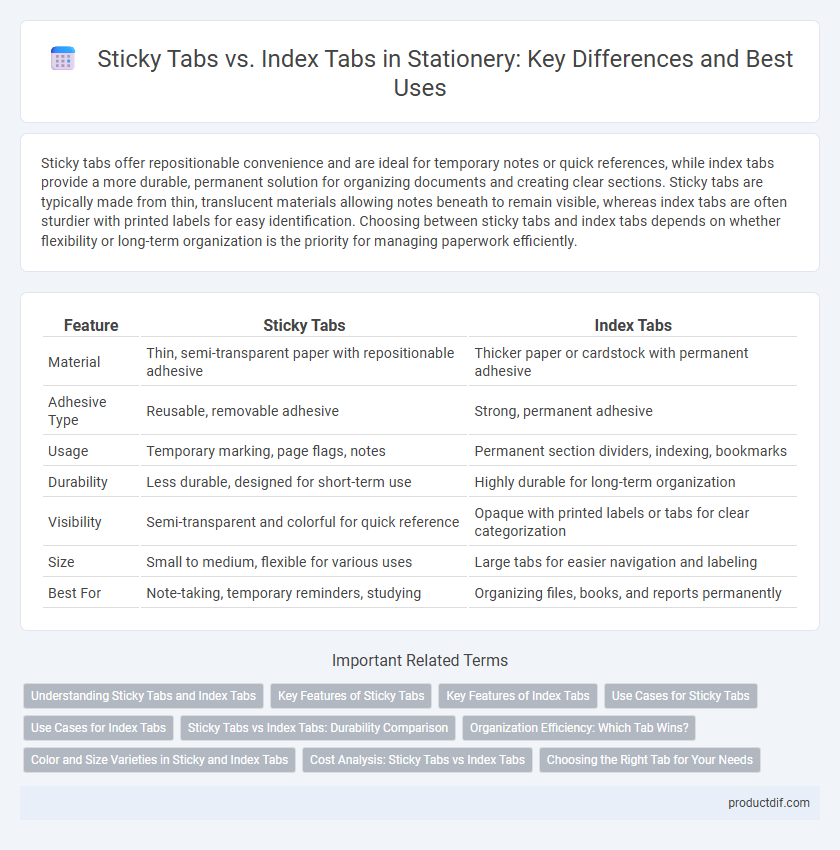Sticky tabs offer repositionable convenience and are ideal for temporary notes or quick references, while index tabs provide a more durable, permanent solution for organizing documents and creating clear sections. Sticky tabs are typically made from thin, translucent materials allowing notes beneath to remain visible, whereas index tabs are often sturdier with printed labels for easy identification. Choosing between sticky tabs and index tabs depends on whether flexibility or long-term organization is the priority for managing paperwork efficiently.
Table of Comparison
| Feature | Sticky Tabs | Index Tabs |
|---|---|---|
| Material | Thin, semi-transparent paper with repositionable adhesive | Thicker paper or cardstock with permanent adhesive |
| Adhesive Type | Reusable, removable adhesive | Strong, permanent adhesive |
| Usage | Temporary marking, page flags, notes | Permanent section dividers, indexing, bookmarks |
| Durability | Less durable, designed for short-term use | Highly durable for long-term organization |
| Visibility | Semi-transparent and colorful for quick reference | Opaque with printed labels or tabs for clear categorization |
| Size | Small to medium, flexible for various uses | Large tabs for easier navigation and labeling |
| Best For | Note-taking, temporary reminders, studying | Organizing files, books, and reports permanently |
Understanding Sticky Tabs and Index Tabs
Sticky tabs feature an adhesive backing allowing them to be repositioned without leaving residue, ideal for temporary notes and quick references. Index tabs, typically made of durable plastic or cardstock, are designed for permanent labeling and easy navigation in binders or folders. Choosing between sticky and index tabs depends on whether you need flexibility and reusability or long-lasting organization.
Key Features of Sticky Tabs
Sticky tabs feature a repositionable adhesive backing that allows easy attachment and removal without leaving residue, ideal for temporary marking and note-taking. These tabs often come in vibrant colors and various sizes for quick identification and organization, enhancing visual indexing in documents. Designed for flexibility, sticky tabs are thinner and more translucent compared to index tabs, making them perfect for highlighting text without obscuring content.
Key Features of Index Tabs
Index tabs provide durable, writable surfaces for clear labeling, enhancing organization in documents and notebooks. They often feature reinforced edges to prevent tearing and come in various sizes and colors for easy categorization. Unlike sticky tabs, index tabs are typically designed to endure frequent handling without losing adhesion or clarity.
Use Cases for Sticky Tabs
Sticky tabs excel in temporary organization, allowing users to mark pages without permanent alteration, ideal for study notes or project revisions. Their repositionable adhesive makes them perfect for frequent updates and quick reference in documents or planners. Unlike index tabs, sticky tabs support color-coding and annotation, enhancing visual management in dynamic workflows.
Use Cases for Index Tabs
Index tabs are ideal for organizing large documents, making it easier to locate specific sections quickly during research or study sessions. They are commonly used in legal files, academic notebooks, and business reports to segment content into clear, labeled categories. By providing visible, durable markers, index tabs enhance workflow efficiency and improve information retrieval in professional and educational settings.
Sticky Tabs vs Index Tabs: Durability Comparison
Sticky tabs offer moderate durability due to their repositionable adhesive, allowing easy removal without damage but may wear out faster with frequent handling. Index tabs typically feature stronger, more rigid materials like plastic or reinforced paper, providing enhanced durability for long-term use and frequent access. For heavy-duty organization, index tabs outperform sticky tabs in resistance to tearing and maintaining structural integrity over time.
Organization Efficiency: Which Tab Wins?
Sticky tabs offer flexibility with repositionable adhesive, making quick annotations and temporary organization simple. Index tabs provide durability and clear, permanent labeling, ideal for long-term document management. For maximizing organization efficiency, index tabs excel in maintaining structured files, while sticky tabs enhance dynamic note-taking and frequent updates.
Color and Size Varieties in Sticky and Index Tabs
Sticky tabs offer a vibrant array of color options, typically available in neon, pastel, and primary hues, enhancing quick identification and organization in documents. Index tabs tend to come in more muted or standard tones with larger size options, providing clearer labeling space for detailed notes or categorization. Both types deliver diverse size varieties, with sticky tabs often smaller and flexible, while index tabs are generally larger and more rigid, catering to different organizational needs.
Cost Analysis: Sticky Tabs vs Index Tabs
Sticky tabs generally offer a lower upfront cost compared to index tabs, making them a budget-friendly option for short-term use and quick referencing. Index tabs, while initially more expensive due to their durable construction and customizable labels, provide long-term value by enhancing document organization and reducing the need for frequent replacement. Evaluating total cost of ownership reveals that investing in index tabs can lead to improved efficiency and cost savings over time despite the higher initial expense.
Choosing the Right Tab for Your Needs
Sticky tabs offer repositionable convenience and vibrant colors ideal for temporary notes or bookmarks, while index tabs provide sturdy, durable labeling perfect for long-term organization in binders or notebooks. Choosing the right tab depends on whether your priority is flexibility and easy reorganization or permanent, clear section division. Evaluate your task requirements and frequency of use to select tabs that enhance productivity and streamline document management.
Sticky tabs vs Index tabs Infographic

 productdif.com
productdif.com